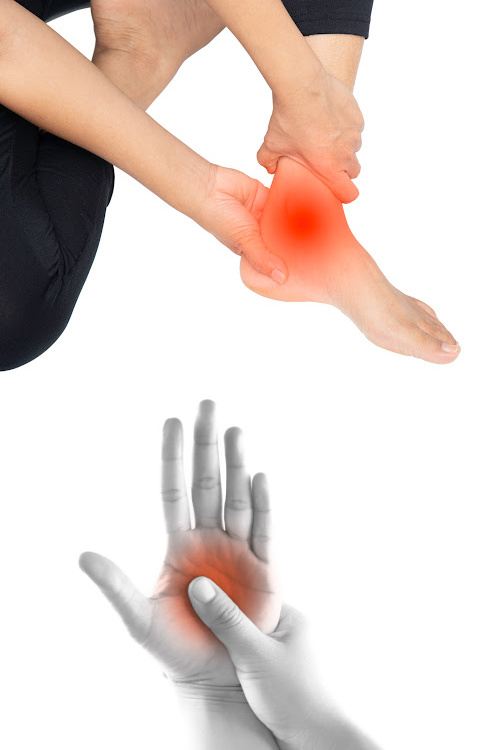Muscle spasms aren’t always a cause for concern, especially if they rarely occur. However, regular muscle spasms should be taken seriously and managed accordingly – especially if you’re experiencing additional symptoms, such as pain. Frequent muscle spasms, such as those in the elbow, can limit your range of motion and disrupt your daily activities.
If you’re experiencing frequent muscle spasms in your elbow, it could indicate an underlying condition that needs attention. Neuragenex Neurofunctional Pain Management (NFPM) can help treat any chronic pain and inflammation you may be experiencing due to your muscle spasms.
Why Do Elbow Muscles Twitch?
Muscle spasms occur when a muscle contracts and tightens involuntarily. This can happen for various reasons, including:
Overuse Or Strain
One of the most common causes of muscle spasms in the elbow is overuse or strain. This can occur from repetitive movements, such as typing for hours on end, or from participating in sports that involve frequent use of the arms. When the muscles in your elbow become fatigued or strained, they can spasm due to the increased pressure and tension.
Dehydration
When dehydrated, your body may not have enough fluids to properly support and lubricate your muscles, leading to tightness and spasms. Additionally, when you become dehydrated, it can lead to an electrolyte imbalance. An imbalance of electrolytes (such as potassium or magnesium) can cause nerve signals in the muscles to misfire, resulting in spasms.
Nerve Damage
In some cases, muscle spasms in the elbow may result from nerve damage. This can occur from previous injuries or medical conditions, such as carpal tunnel syndrome or neuropathy. Nerve damage can disrupt the signals between your muscles and brain, causing them to spasm.
Poor Posture
Poor posture places excess strain on certain muscles and can lead to imbalances that result in spasms. In the case of elbow muscle spasms, poor posture can occur from sitting at a desk for extended periods or from frequent use of mobile devices.
Injury Or Trauma
A traumatic injury to the elbow, such as a fall or impact, can cause muscle spasms as your body tries to protect and heal the affected area. Injuries to the muscles or tendons in the elbow can also result in spasms as they try to repair themselves.
What Medical Conditions Can Cause Elbow Discomfort
The previously mentioned causes of muscle spasms in the elbow are usually temporary. They can often be managed through rest or lifestyle changes. However, there are cases in which the spasms in your elbow may be caused by an underlying condition. The following are some of the common medical conditions that can lead to muscle spasms in your elbow:
Rheumatoid Arthritis
Rheumatoid arthritis is a relatively common autoimmune disorder (one to two percent of the world’s population have the condition). It can cause inflammation that leads to spasms in the muscles surrounding the affected joint, such as in the elbow. Other symptoms caused by rheumatoid arthritis can include swelling, joint pain, and reduced range of motion. The cause of rheumatoid arthritis is unknown, although it’s thought to be a combination of genetic and environmental factors.
Peripheral Neuropathy
Prolonged nerve damage can lead to peripheral neuropathy. This condition affects the nerves outside of the brain and spinal cord. This can cause muscle spasms, pain, numbness, or tingling sensations in the affected area. Peripheral neuropathy has several causes, including diabetes, alcoholism, and vitamin deficiencies.
Cubital Tunnel Syndrome
Cubital tunnel syndrome develops when the elbow’s ulnar nerve is compressed or irritated, making it a ulnar nerve compression condition. This can cause numbness, tingling, and muscle spasms in the affected arm. Cubital tunnel syndrome is commonly caused by repetitive motions that put pressure on the nerve, such as typing or using tools such as a screwdriver.
Golfer’s Elbow
Medial epicondylitis (more commonly referred to as golfer’s elbow) is a common condition among athletes and individuals who perform repetitive wrist movements (such as swinging a golf club). It causes pain, stiffness, and muscle spasms on the inside of the elbow, where the tendons attach to the bone.
Muscular Dystrophy
Muscular dystrophy is a genetic disorder that causes progressive weakness and breakdown of muscles, including those in the elbow. This condition can lead to muscle spasms, as well as difficulty with movement and daily tasks. Muscular dystrophy cannot be cured, but treatment plans can help manage symptoms.
When To Seek Medical Attention
If you are experiencing frequent or recurring muscle spasms in your elbow, it is vital to seek medical attention. Additionally, if your muscle spasms are accompanied by any of the following symptoms, it could be a sign of an underlying medical condition or injury that needs to be addressed:
- Pain
- Swelling
- Numbness or tingling
- Reduced range of motion
How Physicians Diagnose Muscle Spasms Near The Elbow
Generally speaking, a doctor will first ask about the spasms you’re experiencing. They’ll want to know how often you’re experiencing the spasms, exactly where they are occurring, and whether or not there are any other symptoms present.
In order to diagnose muscle spasms near the elbow, a physician will typically start by asking about your medical history and any recent activities or injuries that may have contributed to the spasms. They may also perform a physical exam, checking for tenderness, swelling, and range of motion in the affected area.
Your doctor will also order an X-ray or MRI for a more accurate diagnosis. These imaging tests will allow the doctor to get a closer look at the bones, muscles, and tendons in your elbow. In rare cases, nerve conduction studies may be used to evaluate the function of nerves in the affected area.
At-Home Remedies To Manage Elbow Muscle Spasms
Several at-home remedies can help manage the pain and discomfort caused by elbow muscle spasms. These include:
- Applying ice or heat therapy: Alternating between applying a cold compress and a warm compress to the elbow can help reduce inflammation and soothe tight muscles.
- Taking over-the-counter pain medication: Nonsteroidal anti-inflammatory drugs (NSAIDs) can help alleviate pain and reduce inflammation.
- Stretching and strengthening exercises: Gentle stretches and exercises suggested by a physical therapist can help improve range of motion and prevent future muscle spasms.
- Adjusting ergonomics: If poor posture is contributing to your muscle spasms, making adjustments to your workspace or using ergonomic devices (such as a wrist rest for computer use) can help alleviate strain on your elbow muscles.
- Resting and avoiding aggravating activities: In some cases, resting the affected elbow and avoiding physical activities that may worsen your muscle spasms can help them heal more quickly. This is especially important if the spasms are caused by overuse or repetitive motions.
Conventional Treatment Options For Elbow Muscle Discomfort
In addition to at-home remedies, there are also conventional treatment options for elbow muscle discomfort that your doctor may recommend. These include:
Medications
In cases where at-home remedies are not enough to manage your elbow muscle spasms, your doctor may prescribe medications such as corticosteroids or muscle relaxants. These can help reduce pain and inflammation. However, many of these medications have potential side effects, especially if relied on over a long period of time.
Nerve Block Injections
Your doctor may recommend nerve block injections for severe or chronic muscle spasms. These involve injecting a local anesthetic into the affected area to numb the nerves and provide temporary pain relief. However, these injections may need to be repeated regularly to maintain the effects. Regular use can increase the risk of potential side effects, including nerve damage.
Surgery
In rare cases, when other treatment options have been ineffective, surgery may be recommended to address the underlying cause of your elbow muscle spasms. This could include procedures to release tension on a compressed nerve or to repair damaged tendons. Surgery should only be considered as a last resort due to how expensive it is, how long recovery can take, and the risk of complications that may arise from the procedure. These complications can include infection, nerve damage, scarring, and more.
Neurofunctional Pain Management To Manage Elbow Muscle Spasm Pain
Our Neuragenex NFPM rotocol focuses on treating chronic pain and inflammation caused by a wide range of conditions. We use a Neurofunctional Pain Management approach to treat any pain or inflammation resulting from the muscle spasms you’re experiencing in your elbow. This means that instead of simply temporarily masking the symptoms, we treat the underlying neurological factors contributing to the root cause, allowing us to provide long-term relief from chronic pain.
Our whole-person protocol involves the use of the following non-surgical, drug-free, non-invasive, and non-chiropractic treatment modalities:
Electroanalgesia
Electroanalgesia is a pain management technique that uses high-pulse electrical current to ease pain, boost blood circulation, improve mobility, and induce...
IV Therapy
IV nutritional therapy, or intravenous therapy, involves administering vital nutrients directly to the bloodstream through an IV. This type of treatment bypasses the digestive system, allowing for maximum absorption and utilization of nutrients by the...
Lifestyle Counseling
Lifestyle counseling is an approach to managing chronic pain that involves identifying, assessing, and modifying lifestyle factors contributing to an individual's pain. For example, lifestyle factors such as nutrition, physical activity, stress, sleep quality...
Read More About Muscle Spasm Near Elbow Lifestyle Counseling
Neuragenex NFPM Relieves Conditions Causing Elbow Muscle Spasm Pain
Neuragenex Neurofunctional Pain Management is particularly effective when it comes to treating elbow muscle spasm pain because the underlying cause is often related to conditions that are nerve-related or that cause inflammation, which our protocol is designed to address. We can treat chronic pain caused by the following conditions:

Peripheral Neuropathy Pain Treatment
We offer a unique and leading-edge approach to treating the burning, tingling, throbbing pain that may be associated with peripheral neuropathy or nerve damage. We have helped 100’s of patients, just like you, reduce their pain fast and get back to living...

Rheumatoid Arthritis Pain Treatment
Rheumatoid arthritis can be a debilitating and painful condition that causes swelling, joint damage, and immobility. We offer a non-invasive, non-chiropractic solution to alleviate the pain associated with rheumatoid arthritis. Our treatments are designed to...

Ulnar Nerve Entrapment Pain Treatment
Ulnar nerve entrapment is a condition that affects the arm and hand, causing pain, numbness, and tingling sensations. Ulnar nerve entrapment pain can be debilitating and significantly impact your quality of...
Embrace A Pain-Free Life With Full Elbow Mobility
Elbow muscle spasms can be a painful and frustrating condition to deal with. Fortunately, our Neurofunctional Pain Management approach to treating chronic pain and inflammation can allow us to provide you with the long-term relief you need to embrace a pain-free life with full elbow mobility. Contact us today to learn more about the Neuragenex NFPM protocol and how we can help you find relief from your elbow muscle spasm pain.
Ready to experience relief?




